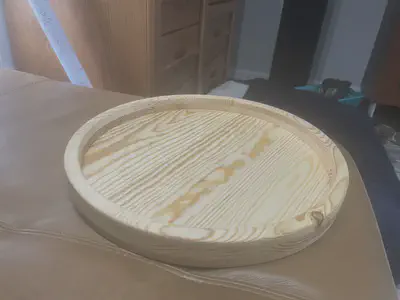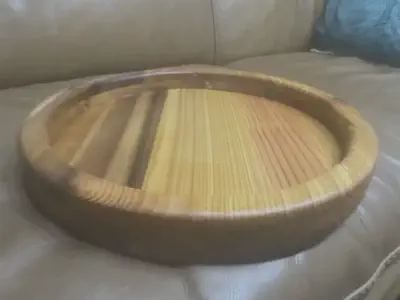Circular Serving Tray

This was my first project heavily using the router: The circle for the bottom and the two rings for the sides were all cut with the router, so there was a LOT of learning which happened there.
Pictures
 |  |
| Finished#1, pine | Finished#2, cedar |
Lessons Learned
Jointing
- When face jointing boards, you don’t need to sand when they come off the planar; clamping alone will give you a nice result. If you sand, you run the risk of sanding things near the edges such that there will be gaps in the two panels once glued which you cannot clamp shut. Your only option at that point is to cut things smaller with the router to get past the affected area(s) near the edge.
Measuring and Cutting
Using a trim router to cut these pushes the limit of what it can do. There was some minor smoking/burning on some of the pine bits which I think might have been due to it bogging down.
Cut your initial circle/thing with a router about 1/2" larger than you want the final product to be. Since I was just using a nail+straightedge guide to more or less freehand these cuts, there is a non-neglible chance that something is going to jerk and ruin the cut near the edge; this only happens on the initial cuts. Such things are easily cleaned up with shallower polishing passes.
A plunge router is the correct tool for this sort of thing; my plunge base wasn’t compatible with my edge guide, so I didn’t use it. I had to “tip” in the router while it was on, which is doable but also very error prone.
Taking multiple passes of no more than 1/4" deep with a 1/4" bit is needed for best results with my little Makita trim router.
A dedicated jig with a immobile arm for the radius of the circles I’m cutting (made of wood/metal) would have made this soooo much easier.
Sanding
- You need a foam pad on your ROS if you are going to use it to sand curves like this. The flat plate it comes with just won’t work, esp. on the inside curve. Doing said curve by hand is really time consuming, and results in a subpar finish (granted, this was my first time trying to hand sand something like that). Plus, the foam pads are like $10 for a pack of 5, so they are cheap, and work pretty well.
Finishing
- The cedar version of this project could have really benefited from some finishing wax, but I didn’t have any, so I used butcher block oil/conditioner instead.